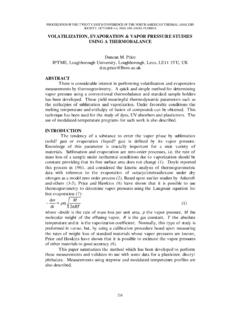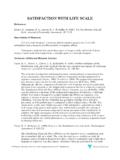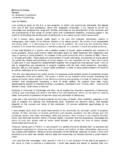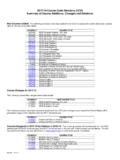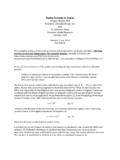Transcription of Photo by Mark ‘Gonzo’ Lumley - sump4.com
1 THE WATERS UNDER THE EARTHIn 1991 Michael Trebor McDonald produced the third edition of the Somerset Sump Index. Building on the text written by Phil Davies (1957) and Ray Mansfield (1964) Trebor wrote in his introduction to the entry for Wookey Hole:If the Cave Diving Group was considered to have been conceived in Swildon s Hole, then it was most certainly nurtured and cradled in Wookey Hole, where many great diving scenes have been enacted, from light-hearted water romping to toil and triumphant discovery but also to grim tragedy. The present extent of exploration represents the greatest achievement of the CDG in Somerset, although Gough s Cave in Cheddar is running second.
2 The Wookey explorations which started in 1935, are still progressing, albeit at a slow and intermittent pace. The sharp end of the cave deep beyond Wookey 25 represents the very forefront of diving techniques and human endeavour. It is felt that the equipment side of the equation has to catch up with the human side. Divers are perfectly capable of diving and operating at such depths and remoteness, but the use of cylinders is, or has become, awkward and impractical. New equipment such as rebreathers will have to be perfected. It is poignant to note that Wookey explorations commenced with rebreathers and we have come full circle to start considering their use again for deep, remote cave retrospect, these words were somewhat prophetic!
3 By the turn of the 21st century most people had written off the upstream end of Wookey Hole as impassable. Several divers had put in concerted attempts to dig their way through the blockage that had first defeated Rob Parker in 1985 and no one had ever got as far as him. Gavin Newman had made a film of the cave up to the limit of exploration and most cave divers were content to see the end from the comfort of their sofas. It was, however, the ability to inspect the limit of the cave at leisure which led Rick Stanton to comment to John Volanthen that something wasn t right about the shape of the gravel deposits on the passage floor and that there might be a way around the gravel blockage on the opposite side from the line.
4 A plan was hatched to go and have a by Mark Gonzo Lumley329330 WOOKEY HOLE - 75 YEARS OF CAVE DIVING & EXPLORATIONRick Stanton hails from Epping Forest in Essex and wanted to be a cave diver ever since he saw Underground Eiger (the film by Sid Perou of Oliver Statham and Geoff Yeadon s traverse from Kingsdale Master Cave to Keld Head) on TV in 1979. Rick recalls that it was his mother who suggested that he might be interested in the programme. Shortly afterwards, Rick went to Aston University where he simultaneously joined the caving club and sub-aqua club so as to fulfil his ambition. It was almost on the other side of the world, in Peru, that Rick met up with Ian Rolland on an Army Caving Association expedition in 1987.
5 Ian was also a cave diver and had supported Rob Parker on his 1985 dive. Ian was very active in South Wales where he was busy pushing cave passages beyond sumps in Ogof Daren Cilau. Rick was invited to join Ian on his explorations and they were very successful in discovering the Inca Trail (named after their Peru trip) extensions in the knew Ian as well, since we were both members of the Chelsea Speleological Society. Although I was born and brought up in Somerset, in the village of Chilcompton only 12 miles from Wookey Hole I had taken up scuba diving in my teens before being introduced to caving by a school friend during the summer vacation after my first year at Exeter University in 1983.
6 During my postgraduate studies at Birmingham University I had spent far too much time digging in Agen Allwedd where Ian had helped out on occasion. One thing led to another, and I started cave diving as a means of getting to promising dig sites beyond sumps under the watchful tutelage of Ian Rolland and Martyn 1990, I had moved to Coventry where I had a job with a major chemical company. Rick also worked in Coventry as a fire-fighter (he frequently turned up at my employers whenever the alarm went off). Ian suggested that Rick and I should do some caving together, and we subsequently undertook the excavation of the Pwll-y-Cwm resurgence to the Llangattock caves in the Clydach Gorge in order to establish a convenient backdoor.
7 This facilitated further cave diving discoveries in Daren Volanthen and I first met in October 1998 when we went for an evening trip in Ogof Capel. My diving watch was still set to British Summer Time and we ended up rushing out of the cave only to find that we had an extra hour of drinking time. John comes from Brighton and first started caving with the Scouts in 1982. The surname Volanthen is unusual, being an anglicised form of the family name of Von Lanthen which was held by John s Swiss grandfather. As a consequence John is frequently known by the affectionate nickname of Volleyball. My dive logs show that whilst I did a fair amount of cave diving with Rick or John, it was not until the Wookey Hole dives described here, that the three of us got to work 2002, Rick and John combined forces in order to push on from Rob Palmer s upstream limit in Gough s Cave.
8 This required the use of a rebreather to ease the logistics and Rick was well-placed to be an expert in such technology, having been part of the 1998 explorations to Wakulla Springs in Florida led by Bill Stone. The diving there had used sophisticated computer-controlled mixed-gas rebreathers, sonar underwater mapping devices mounted to long range diver propulsion vehicles and submersible decompression chambers borrowed from the marine oil exploration industry. It will not surprise readers to learn that Bill Stone is currently developing autonomous robotic underwater cave mappers for use in the sub-glacial lakes of Antarctica and beneath the ice-covered oceans of Europa, one of Jupiter s moons.
9 Wookey Hole Cave Divers get everywhere!Rick s rebreather, dubbed the RS2000, was less sophisticated, but nevertheless, most effective. He had put this together from various second-hand components during 2000. The RS2000 did the job in Gough s Cave and Rick was able to surface in a blind airbell in the middle of the boulder choke at the end of Sump 3 first reached by Palmer in proposed dive at the end of Wookey would require a more streamlined rebreather than the one used at Cheddar. Rick devised a novel side-mounted rebreather which could be worn like conventional cave diving cylinders rather than more traditional rebreathers which are commonly worn on the back (or chest).
10 Interestingly, the concept of mounting a rebreather under one s arm 331pit was not new to cave diving as Steve Wynne-Roberts had used his innovative ATEA/SEBA side-mounted oxygen rebreather in Swildon s Hole, Stoke Lane Slocker and other caves during the 1960s (Chapter 10). Rick s unit was capable of operating at depths approaching 200 m. Two galvanic cells were used to monitor the breathing loop for oxygen content and a constant mass-flow orifice matched the addition of this gas closely to the diver s metabolic rate so that only small corrections were required. With the appropriate choice of make-up gas (air or Trimix) the wearer could stay underwater at almost any depth for several genesis of this device, however, was far more interesting.


